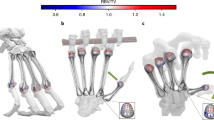Abstract
Recent studies,Rightmire (1972) andDay andScheuer (1973), have investigated the affinities of early hominid metacarpals from Swartkrans. Because of its extensive use in the analysis of metatarsals, the index of robusticity has also been applied to some fossil metacarpals. From the metatarsal analyses, it has been shown that within a group a variety of robusticity patterns exist with the average pattern occuring approximately 50 per cent of the time. This, coupled with the fact that it has also been shown that within the order Primates the pattern is not necessarily diagnostic of any locomotor category, has led us to investigate the usefulness of such an index in assessing primate metacarpals.
In this study, metacarpal robusticity patterns and the Total Robusticity Quotient are established for seven cercopithecoid genera and the results correlated with hand use. It is found that although patterns of robusticity are not diagnostic of locomotor categories, the TRQ relates well to hand use: low TRQ's are found in primates which use their hands to walk on a flat substrate, while high TRQ's are diagnostic of arm swinging animals. Primates with reduced thumb use in a precision grip and little manipulative use of the hand have higher TRQ's than those with a good precision grip. The model derived from our sample of Cercopithecoidea is tested with a hominoid sample of four genera and found to be similarly applicable.
Similar content being viewed by others
References
Archibald, J. D., C. O. Lovejoy, &K. G. Heiple, 1972. Implications of relative robusticity in the Olduvai Metatarsus.Amer. J. Phys. Anthrop., 37: 93–95.
Carpenter, C. R. &N. M. Durham, 1969. A preliminary description of suspensory behavior in nonhuman primates.Proc. 2nd int. Congr. Primat. Karger, Basel. pp. 147–154.
Day, M. H. &J. L. Scheuer, 1973. SKW 14147: A new hominid metacarpal from Swartkrans.J. Hum. evol., 2: 429–438.
Napier, J. R. &P. H. Napier, 1967.A Handbook of Living Primates. Academic Press, London.
Preuschoft, H., 1973. Functional Anatomy of the upper extremity. In:The Chimpanzee, Vol. 6, G. H. Buorne (ed.) Karger, Basel. pp. 34–120.
Riesenfeld, A., 1972. Metatarsal robusticity in bipedal rats.Amer. J. Phys. Anthrop., 36: 229–233.
————, 1974. Metatarsal robusticity in primates and a few other plantigrade mammals.Primates, 15: 1–25.
Rightmire, G. P., 1972. Multivariate analysis of an early hominid metacarpal from Swartkrans.Science, 176: 159–161.
Tuttle, R., 1972. Functional and evolutionary biology of hylobatid hands and feet. In:Gibbon and Siamang, Vol. 1,D. M. Rumbaugh (ed.), Karger, Basel. pp. 136–206.
Author information
Authors and Affiliations
About this article
Cite this article
Siegel, M.I., Pernotto, B. Hand use and metacarpal robusticity in Catarrhini. Primates 16, 371–377 (1975). https://doi.org/10.1007/BF02382736
Received:
Accepted:
Issue Date:
DOI: https://doi.org/10.1007/BF02382736



